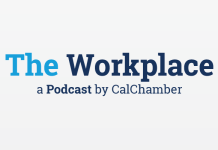In this episode of The Workplace podcast, CalChamber Associate General Counsel Matthew Roberts and CalChamber Senior Policy Advocate Ashley Hoffman discuss the recent guidance released by the California Labor and Workforce Development Agency on changes to the California Private Attorneys General Act (PAGA).
Key Changes to PAGA
Earlier this year, Governor Gavin Newsom signed into law historic amendments to PAGA that took effect on June 19. These changes primarily focus on altering penalty distributions and offering employers new avenues for compliance.
Under the reforms, penalties will be allocated more favorably toward employees, moving from a 75-25 split of awards distribution of settlement funds to a 65-35 split, Hoffman explains. This means that a larger portion of penalties will now directly benefit the employees affected by violations.
Additionally, employers now have a clear path to significantly cap their potential penalty exposure. If an employer can demonstrate that they took reasonable steps to comply with labor laws before receiving a lawsuit, they can limit their maximum penalty to just 15% of the applicable penalty.
“Even if they can’t show that they took all reasonable steps prior to receiving the lawsuit, if they can show that they took reasonable steps promptly after receiving it,” they could have that capped at a maximum of 30%, she says.
Another important component of the reform is expanded cure opportunities. The new changes broaden the scope of what can be cured under PAGA, including various wage statement errors and meal/rest break violations. Employers now have the chance to rectify issues before facing severe penalties, which was a substantial limitation under the old law.
PAGA Notice Process
The LWDA’s recent guidance explains the process that employers may expect when an employee initiates a PAGA action against them, Roberts says.
If a lawsuit is initiated, the plaintiff must first file a notice with the LWDA and serve it on the employer by certified mail, Hoffman says. The LWDA then has 65 days to decide whether to investigate the claim.
Roberts points out that if an employer receives such a notice, it should trigger the employer to take certain measures.
Hoffman explains that upon receiving notice, employers should immediately audit their records to identify any violations. If violations are confirmed, the employer can initiate a cure process.
Smaller employers have the opportunity to hold a conference with the LWDA to obtain help facilitating a cure. Larger employers also have the opportunity for a conference and have a neutral evaluator look at the merits of the case as well.
“The goal is quicker resolution, trying to get the parties in a room together as soon as possible,” she says.
What, Roberts asks, does the LWDA look for when an employer proposes a cure process?
Hoffman replies that if violations are identified, employers can propose a “cure” process to rectify the issues, which may involve paying unpaid wages plus interest and reasonable attorney fees.
Roberts points out that while there may be costs involved in this cure process, it still is a significant savings from the substantial penalties and legal fees under the previous system.
Compliance Best Practices
Hoffman stresses that employers should be conducting audits of company practices and reviewing company policies every year—especially when new laws come out and there are new court cases and legal developments.
Employers should also review the training of supervisors and employees on compliance matters. Employers should ensure that meal and rest break polices are correctly followed.
Roberts adds that employers should also stay in touch with an organization like the CalChamber that puts out compliance resources, toolkits and other materials to help with audits and training.

